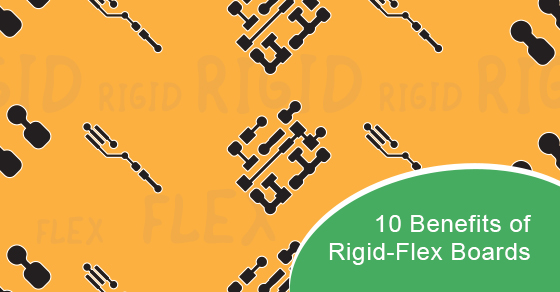10 Benefits of Rigid-Flex Boards
Rigid-flex circuits provide more advantages to the user than traditional rigid boards and flex circuits. This hybrid between rigid and flexible circuits improves quality control and performance. Now more than ever, you can find rigid-flex boards inside numerous devices. Some are small and simple, and others are large and complex. The wide array of applications for rigid-flex boards has made it an industry favourite because they can be used to address a lot of common issues.
If this is your first time hearing about rigid-flex boards, not to worry. When it comes to circuit board design in Toronto, we’ve got all the information you need. Keep reading to see why rigid-flex boards are increasing in popularity every day.
1. Packaging is reduced
Electronic devices continue to get smaller, and PCBs are following suit to ensure proper connection of components. Some would say that the design of these smaller boards is the driving force behind product miniaturization.
The compact nature of a rigid-flex PCB means it can be bent or folded to fit small electronics. They have the same circuit density and precision as rigid PCBs but tend to be much lighter due to their size. And as a single integrated unit, rigid-flex PCBs can replace multiple PCBs, connectors, and wiring harnesses.
2. esign flexibility
Rigid-flex PCBs have a 3D design of multiple layers of flexible circuits. Because those layers are flexible, you can use them in any size design.
Rigid-flex PCBs accept any component or connector that can be assembled to a rigid PCB design. The ends are typically flexible for flexible connections. That means, unlike rigid boards, you won’t have to match your device design to the specifications of your PCB. And you can also add rigidness where required for extra mechanical support.
3. More reliable
Rigid-flex circuits are integrated units. There are no additional points of interconnect between separate rigid component areas. Why is this beneficial? With reduced interconnect points like solder joints, connectors, and crimps, there is a reduced number of failure points within the design.
Most advanced electronic applications (especially for military and medical devices) will use rigid-flex PCBs because they’re less prone to circuit failures. There also valued for their heat resistance. Polyamide’s thermal stability allows these circuits to handle extreme heat.
4. Manufactured tough
In addition to heat resistance, rigid-flex PCBs can also be manufactured to perform well in other harsh environments. In addition to being impervious to heat, rigid-flex PCBs are designed to protect against moisture, solvents, oils, acids, and basics. They also have outstanding chemical and UV ray resistance. Furthermore, they can also withstand extreme vibrations, shocks and a wide temperature range (-200°C to 400°C).
5. Stability and durability
Arguably the most notable feature of a rigid-flex PCB is its flexibility, but how long does it last? Rigid-flex boards are made to turn, twist and repeatedly bend without lasting impact. The minimum bending angle of the flex section on a rigid-flex board is 90°.
The thinner and longer the flex section is, the more flexibility the board has. Some boards with long flex sections can roll more than 360°! With proper design, a flexible circuit should withstand countless flexes.
And compared to flexible printed circuits, rigid-flex boards are more durable and stable. The coupling of stability and durability make rigid-flex boards perfect for use in corners of devices like laptops or smartphones.
6. More cost effective
Blank rigid-flex boards are harder to produce than other types, which typically makes them more expensive. However, you save money when it comes to assembling your PCB. Flex circuits can only be applied one way, reducing costly assembly mistakes. And as a complete circuit, there’s no need to buy and install a wire harness.
The smaller size of rigid-flex PCBs means fewer connections and fewer materials required. Fewer parts and materials needed for each unit increase your yield and reduce the final product's purchasing and assembly costs. If you’re selling the final product, you’ll experience fewer supply chain issues with fewer parts preventing big losses.
7. Rigidity
Rigid-flex PCBs are perfect for devices that experience excessive vibration or movement during use. While they are known for their flexible, mobile nature, components must stay where you place them.
Rigid-flex PCBs parts are fixed in place by solder flux. This allows them to remain static during heavy movement.
8. Repair and maintenance convenience
An exposed signal path and simple design make repairing and maintaining flex-rigid boards simpler than their counterparts. The 3D design allows it to be twisted and folded so repair techs can touch and fix whatever and wherever they need to.
There are no board-to-board connectors to manoeuvre, and the circuit is relatively easy to clean and debug. This makes it easy to spot and correct faults in the board during regular maintenance. And unlike other circuits, all components on a rigid-flex board are marked, making assembling and disassembling much easier.
9. More aesthetically pleasing
While aesthetics may be the last thing people consider when dealing with circuit materials, it is important. A rigid-flex board may be the best option if it’s likely that the user will be interested in the functional aspects of the product. The last thing you’ll want is for them to be dissuaded by messy circuits.
10. No human error
Most human errors occur when users attempt to use discreet wires for interconnection. Rigid-flex boards remove this possibility.
As an integrated circuit assembly with all interconnections controlled by the design, the chance of someone messing up making an interconnection is eliminated.
Call Us
Our team at Circuits Central has over 25 years of experience with circuit board design in Toronto. Call us at 1-888-602-7264 or click here to request information.

